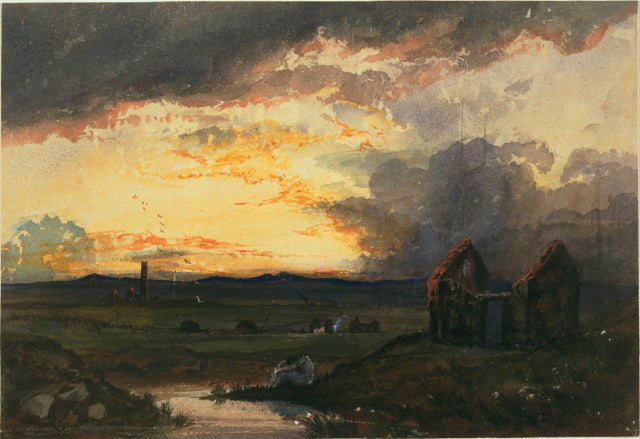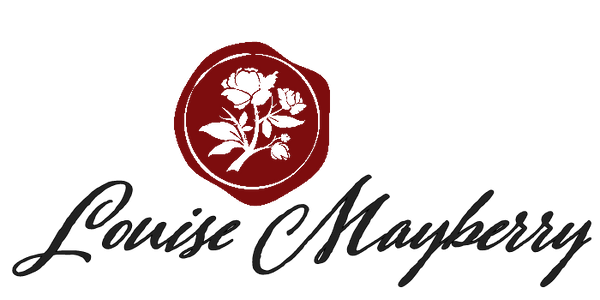
My new personal hero.🌹
Share
12.13.24
Hi There!
I'm coming to you a day late.
It's birthday week at my house - my husband's and my soon-to-be twelve year old son's.
That, along with Christmas preparations and the scramble to finish the first draft of my novella before the kids' winter break has left me rather breathless.
But I've been waiting to tell you this story, and breathless or not, I just couldn't push it off any longer.
The painting above is called 'Dreams of Escape. Ireland 1846'. It was inspired by a trip the artist took to Ireland with her siblings and her father during the Great Famine. (How's that for a family vacation?)
It's a haunting scene - the stunningly vibrant sunset contrasting with the skeleton of a stone house, the despairing figure, the magical feel to the water and the luminescent flowers dotting the foreground...
It's the perfect introduction to the art and life of a woman who I learned about just recently, as I was researching my novella. I'd never heard of her before, but the more I learned, the more intrigued I became. And I can now say that in all my years of research I've never been so fascinated or inspired by a historical figure.
Let me introduce you to Barbara Leigh Smith Bodichon.

Barbara was born in Sussex, in the south of England, in April of 1827, to parents who very well could have starred in their own Regency romance.
Her father was Benjamin "Ben" Leigh Smith, the eldest son of a wealthy radical abolitionist MP. Her mother was Anne Longdon, a milliner from Derbyshire.
Anne and Ben were from different worlds, and different classes. How exactly they met is unknown, but it is certain that they fell in love and soon Anne found herself with child.
Shockingly, they didn't marry. Ben had grown up around radicals, and believed that the marriage laws of the day (which deemed a wife the property of her husband) were unjust.
Neither did he desert his sweetheart with her burden. (An all too common and acceptable course for a man of his station.)
Instead, Ben and Anne made a family.
Flinging propriety aside, they cohabitated and raised Barbara and her four siblings in the open. By all accounts, Ben was a doting father. He even had a large traveling carriage specially made to fit his entire brood so they could traverse the countryside together.
Ben's family, however, were not understanding of his choice not to marry. Neither his sister nor his mother ever acknowledged his family.
(Interestingly, Ben's sister Fanny married William Nightingale and was the mother to the famous Florence Nightingale. Florence and Barbara were of the same generation and had many acquaintances in common, but Florence never once acknowledged her Leigh Smith cousins.)
In 1833, Anne fell ill with tuberculosis, and despite Ben's desperate attempts to find a cure, she died in 1834. Grief-stricken, he turned his attention to his children and to radical politics, winning a seat in the House of Commons.
Growing up in the countryside in Sussex (with a well-known radical as a father), Barbara rubbed shoulders with the preeminent artists, intellectuals and Bohemians of her day. From this foundation, and with an encouraging, loving father behind her, she quickly grew into her own as both an artist and an activist.
Barbara studied with the great painter Holman Hunt. She was intimate with many of the men who made up the Pre-Raphaelite brotherhood, and her paintings were exhibited at the Royal Academy (though as a woman she was ineligible to enter as a student.) She had many female artist friends, whom she encouraged and brought together in a "Sisterhood" of friendship and support.
Her best friend was Marian Evans, better known as George Eliot - one of the most highly regarded novelists of the Victorian age.
But she wasn't only an artist. As an activist, Barbara was a passionate advocate for women.
She campaigned against the tight corsets of the time, publishing many articles and this amazing lithograph in support of her cause.
She was a close friend of Dr. Elizabeth Blackwell, the first woman in the US to receive a medical degree. They corresponded regularly, with Barbara being very interested in bringing Blackwell's progressive ideas about women's health into Britain.
She was also a fierce critic of the marriage laws, and their unjust treatment of women. In 1854, she wrote 'A Brief Summary in Plain Language of the Most Important Laws Concerning Women', a pamphlet which was instrumental in the passage of the Marriage Property Act.
All of this is just scratching the surface. She was a great organizer, and a great friend, and she stood at the center of both the art world and the emerging movement for women's rights.
Together with her friends, she successfully campaigned to allow women artists into the Royal Academy, forcing their hand by submitting paintings with only the first initial so the men wouldn't know they were painted by women. She founded Girtin College, the first college for women in Cambridge. She established The English Woman's Journal, a periodical concerned with women's employment and equality' and she organized countless other initiatives surrounding suffrage, education and equal rights.
Can you see why I'm enamored with this lady?
(And I haven't even touched on her love life yet! That will have to be the subject of another email.)
But here's the question that really intrigues me about Barbara Leigh Smith Bodichon:
Why haven't we heard of her?
She did so many amazing, cutting-edge things. Was instrumental in so many important and impactful movements . . . Why isn't she more prominent in the history books?
I've read several historians' takes on this question, and they all seem to agree. It's precisely because she did so much that she'd not well known. Her legacy is simply too complex, and too diffuse.
Most "important" historical figures are known for doing one thing. Pursuing a noble goal and transforming the world in some way.
Florence Nightingale was a nurse. Elizabeth Blackwell was a doctor. George Eliot was a novelist. Amazing women, but all easily labeled. Their stories are simple to tell.
But Barbara isn't so easy to pin down. She was so many things: an artist, an activist, an organizer, a champion, a friend... She helped push women forward on so many fronts, her contribution to history is arguably just as great (or greater) than her famous cousin Florence. But it's diffuse, and hence easier to ignore.
Interesting, huh?
In the new year, we'll delve into Barbara's love life... which is a whole other topic. :)
Have a great weekend. I'll see you next Thursday!
All my best,
All my best,

